WTOPCSvr DLL User’s Guide
The WinTECH Software Rapid Development DLL for OPC Servers, (WTOPCSvr), provides an easy to use
API for integrating custom data with OPC. All the details of COM and OPC are handled by the DLL, which
allows an application to present data points to OPC at a high-level, without having to be concerned with the
actual implementation of the underlying interfaces. The DLL may be easily integrated with existing
applications, or new ones. All required OPC Interfaces are supported for both OPC 1.0 and OPC 2.0 Data
Access Standards as well as the Browse Interface.
WTOPCSvr basically operates as a data librarian. The controlling application creates Process Tags by passing
a name and value to the DLL. The DLL records the data point and makes it available to any OPC Client
application by name. The controlling application may change the value of the data at any time, and all attached
clients would be automatically notified. Callback notification is provided for any Process Tag that is modified
by an OPC Client connection. (The application has control over which tags are OPC_WRITEABLE.)
WTOPCSvr now supports dynamic creation of OPC Tags. A callback function is supplied which returns
control to the application if a client requests a tag that has not been previously defined. The application may in
turn create the tag using the requested path and name combination or ignore the request.
�
Creating a Custom OPC Server using WTOPCSvr.DLL
Installing the OPC Proxy DLL’s
The first step in creating an OPC Server is to obtain and install the OPC Proxy/Stub DLL’s from
OPCFoundation (http://www.opcfoundation.org)
Download and upzip the proxy/stub files.
Copy opccomn_ps.dll, opcproxy.dll, opcae_ps.dll, opchda_ps.dll to the SYSTEM32 Directory. *Be sure
not to overwrite any newer versions*
Type REGSVR32 opccomn_ps.dll
Type REGSVR32 opcproxy.dll
Type REGSVR32 opc_aeps.dll
Type REGSVR32 opchda_ps.dll
You will also need to download and install the OPC Server Browser Object supplied by the OPC Foundation.
The OPC Foundation also advises that you verify that your system contains the actxprxy.dll and if not, install
the ActiveX Redistributable Installation Kit from Microsoft. The aprxdist.zip file containing the Microsoft
software is also available from the OPC Foundation Web-Site.
Link WTOPCSvr.lib with the Application
WTOPCSvr.lib contains the export definitions for the DLL’s API. Include this file with the project files for the
custom application and include WTOPCSvrAPI.h with those modules which will be making calls into the DLL.
Generate a new CLSID
Each OPC Server is identified by a unique CLSID. The GUIDGen.exe utility supplied by Microsoft may be
used to generate a unique identifier for the new server application. Run GUIDGen.exe, (located in the Visual
C++\Bin directory). Generate a new CLSID and copy to the clipboard to be pasted in to your server application
as described below.
�
Registry Entries
The WTOPCSvr.DLL exports two API functions that make modifications to the Windows Registry for
installation of the custom server.
UpdateRegistry (BYTE *pCLSID_Svr, LPCSTR Name, LPCSTR Descr, LPCSTR ExePath);
UnregisterServer (BYTE *pCLSID_Svr, LPCSTR Name);
These functions take as arguments the CLSID generated above, (as well as text strings to identify and describe
the new server). While the UpdateRegistry and UnregisterServer functions may be called from the controlling
application at any time, it is generally preferred to implement the registry functions based on command-line
entries during start-up of the application. A self-registering server would process the \RegServer and
\UnregServer command line options similar to the code below, (extracted from OPCSimSvr Application):
const GUID
CLSID_OPCSimSvr = {0x99b8f471, 0xc027, 0x11d2, {0x80, 0xb8, 0x0, 0x60, 0x97, 0x58, 0x58, 0xbe}};
BOOL COPCSimSvrApp::InitInstance()
{
TCHAR szTokens[] = _T("-/ ");
CString HelpPath;
CString SvrName, SvrDescrip;
int
i;
HelpPath = AfxGetApp()->m_pszHelpFilePath;
i = HelpPath.ReverseFind('\\');
HelpPath = HelpPath.Left(i+1);
HelpPath += "OPCSIMSVR.EXE";
//
// Self-Registration code
// (look for cmdline options to register & unregister server)
//
SvrName = "WinTECH.OPCServer";
SvrDescrip = "WinTECH Software OPC Server Simulator";
CString tempCmdLine(m_lpCmdLine);
LPTSTR lpszToken = _tcstok(tempCmdLine.GetBuffer(1), szTokens);
while (lpszToken != NULL)
{
if (_tcsicmp(lpszToken, _T("UnregServer"))==0)
{
UnregisterServer ((BYTE *)&CLSID_OPCSimSvr, SvrName);
return (FALSE);
}
else if (_tcsicmp(lpszToken, _T("RegServer"))==0)
{
UpdateRegistry ((BYTE *)&CLSID_OPCSimSvr,
SvrName,
SvrDescrip,
HelpPath);
return (FALSE);
}
lpszToken = _tcstok(NULL, szTokens);
}
�
Initialization of WTOPCSvr.DLL
The Windows Registration functions described above may be called prior to the initialization of the
WTOPCSvr.DLL. During the self-registration process, the focus is on making the necessary changes to the
Registry and then exiting the application. There is no need at this point to go through the effort of initializing
DCOM and loading up the OPC Server support. The exported function:
InitWTOPCsvr (BYTE *pCLSID_Svr, UINT ServerRate);
does just that. When this function is executed, the DLL performs all necessary initialization of COM/DCOM
and creates the OPCServer Interface object to be used for client connections. The specified ServerRate defines
how fast the OPC Client data connections are refreshed.
Creating Process Tags
After initialization, the WTOPCSvr.DLL is now ready to accept data points from the custom application. Three
exported functions are provided:
CreateTag (LPCSTR Name, VARIANT Value, WORD InitialQuality, BOOL IsWriteable);
UpdateTag (HANDLE TagHandle, VARIANT Value, WORD Quality);
UpdateTagByName (LPCSTR Name, VARIANT Value, WORD Quality);
SetWtOPCsvrQualifier (char Delimiter);
As each process tag is created, the DLL returns a HANDLE to identify the point for future references,
(updates), from the application. The naming convention used by WTOPCSvr.DLL for browsing operations,
(OPC_NS_FLAT or OPC_NS_HIERARCHIAL), is a function of how the names are assigned by the
controlling application. If segmented names are used to create the tags, (strings containing the delimiter ‘.’,
such as “PLANT A.PROCESS1.TAG17”), WTOPCsvr.DLL will automatically configure the name space as
hierarchial, otherwise a flat name space is used. If you want to use a delimiting character other than ‘.’, you can
select it using SetWtOPCsvrQualifier().
Dynamic Tag Creation
If the design warrants, WTOPCSvr.DLL may be used to provide for dynamic creation of OPC Tags as
requested by attached clients. Rather than create all the OPC Tags up-front, the application may choose to have
the DLL issue a callback function whenever an OPC Client requests a tag name that is not already listed.
EnableUnknownItemNotification (UNKNOWNITEMPROC lpCallback);
If enabled, the callback function will receive control anytime a client requests a tag that has not been previously
defined. The requested tag name and path may then be used as arguments to CreateTagA() to dynamically
create the tag before returning from the callback and giving control back to the client. If the application chooses
to ignore the request, the client will receive a OPC_E_UNKNOWNITEMID response from the DLL.
WTOPCSvr.DLL also supports a user callback function that indicates when the last client reference to a tag has
been removed. This may be used by the server application to delete the tag when it is no longer needed. The
following exported function enables this functionality:
EnableItemRemovalNotification (ITEMREMOVEDPROC lpCallback);
�
The callback will receive the handle to the removed item, as well as the path and item names.
Write Callback Notification
If process tags are created as OPC_WRITEABLE, attached client applications may change the value of data
points contained within WTOPCSvr.DLL. WTOPCSvr.DLL provides the ability for the controlling application
to define a callback routine for notification of client writes. This would be required in most situations to allow
the server application to accept the new value and perform the write to the actual device.
EnableWriteNotification (WRITENOTIFYPROC lpCallback);
If enabled, the callback function will receive the HANDLE of any data point written by an attached OPC Client,
as well as the value to be written and a pointer to an error DWORD to allow feedback to the client if the write
operation fails
Clean-up Functions
The only remaining functions exported from WTOPCSvr.DLL provide the mechanism for gracefully closing
the custom server.
int NumbrClientConnections ();
void RequestDisconnect ();
RemoveTag (HANDLE TagHandle);
UninitWTOPCsvr();
Generally, the server logic should check to see if any OPC Clients are connected before allowing the application
to close. OPC 2.0 clients may be requested to disconnect. Any tags created by the application should be
removed using the defined function. The UnintWTOPCsvr() function calls CoUnitialize and should be placed
in the ExitInstance procedure of the application.
Performance Related Functions
Beginning with version 4.0 of the WtOPCsvr.dll, there have been several extended API functions added to
support more efficient updating for large item counts. The dll now supports an option to use hashing for storage
and lookup of text strings representing item names. Significant performance gains are provided in the areas of
intensive string manipulation such as the item browsing functions. A second series of API functions improves
upon the data update cycle by updating multiple items with a single command rather than one at a time. The
WtSvrTst2 example application that is packaged with the WtOPCsvr.dll may be used to generate performance
numbers using various tag counts and various combinations of these two options. Refer to the API descriptions
below for detailed information relative to the use of these functions.
�
OPC Alarms & Events
The WtOPCsvr.dll provides basic support for the Alarms & Events standard by providing level checking for
each process tag. The dll will automatically create an OPC A&E Server using the same CLSID as the Data
Access Server. As each tag is created, the controlling application may specify two levels of high and low alarm
limits surrounding it’s value. As a tag’s value is updated, either by the controlling application or by an attached
client, the dll will check its value against these limits and generate the appropriate A&E messages if exceeded.
These messages are accessible from any standard OPC A&E client application. WtOPCsvr.dll also exports
functions that allow the controlling application to generate textual events to any interested client. Finally, if
greater control over A&E Server operation is desired, the application may disable the internal limit checking
and process all the A&E Interface calls from a client directly. A simple callback object is provided that may be
overridden by the application to process the individual A&E Interfaces as required.
NT Security Additions
To accommodate OPC Server designs where it is desired to control access to certain tags based on the identity
of the connected user, WtOPCsvr.dll supports api functions that allow a security mask to be applied for both
read and write access to individual tags. The user may then define a list of user names with specific rights.
When the security option is enabled, WtOPCsvr.dll will verify the access rights of the client against the sever
defined user list and allow or deny access accordingly. Additionally, an extended write callback is provided
that contains the user name of the client making a write requiest for a tag. This information may then be used to
maintain an audit trail of users who have updated a particular tag.
�
WTOPCSvr.DLL Exported functions
Initialization and Registry Functions
BOOL InitWTOPCsvr (BYTE *pCLSID_Svr, UINT ServerRate);
Use this function to initialize DCOM and create the OPC Server.
CLSID_Svr defines the CLSID which OPC Clients will use to connect to this server.
ServerRate is expressed in msecs and defines the rate at which client connections are updated.
The return value will be TRUE if the function succeeds, otherwise FALSE.
BOOL UpdateRegistry (BYTE *pCLSID_Svr, LPCSTR Name, LPCSTR Descr, LPCSTR ExePath);
This function makes modifications to the Windows Registry to allow other applications to find
and execute the server.
CLSID_Svr defines the CLSID which OPC Clients will use to connect to this server,
(this is a BYTE Pointer to the C-style GUID structure).
Name defines the Server Name
Descr may be anything to describe the server, and will usually contain the vendor name.
ExePath defines the full Windows Directory path to the executable (i.e. c:\OPC\test\mysvr.exe).
The return value will be TRUE if the function succeeds, otherwise FALSE.
BOOL AddLocalServiceKeysToRegistry (LPCSTR Name);
This function makes additional modifications to the Windows Registry to allow the server to run
as an NT Service.
Name defines the Server Name
BOOL UnregisterServer (BYTE *pCLSID_Svr, LPCSTR Name);
This function removes entries from the Windows Registry.
CLSID_Svr defines the CLSID which OPC Clients will use to connect to this server.
Name defines the Server Name
The return value will be TRUE if the function succeeds, otherwise FALSE.
�
Tag Creation & Update Functions
HANDLE CreateTag (LPCSTR Name, VARIANT Value, WORD InitialQuality, BOOL IsWriteable);
This function creates a process tag within WTOPCSvr.DLL.
Name defines the identifier that OPC Clients will use to access the tag. This name may be any
string of text as required by the server. Segmented names, (those containing the delimiter
character ‘.’), are valid and will cause WTOPCSvr.DLL to structure the OPC name space as
hierarchial, for browsing operations.
Value defines the initial data to be associated with the tag
InitialQuality defines the OPC Quality flags associated with the tag.
IsWriteable determines whether or not the tag may be written from an OPC Client
The return value will be a HANDLE to the created point or INVALID_HANDLE_VALUE if
the tag could not be created.
BOOL SetTagProperties (HANDLE TagHandle, DWORD PropertyID, LPCSTR Description,
VARIANT Value);
Any number of OPC Item properties may be set for a defined tag with this function. The DLL
maintains a list of all defined properties and their current value for access by an OPC Client.
The return value will be TRUE if the function succeeds, otherwise FALSE.
BOOL UpdateTag (HANDLE TagHandle, VARIANT Value, WORD Quality);
BOOL UpdateTagWithTimeStamp (HANDLE TagHandle, VARIANT Value, WORD Quality,
FILETIME timestamp);
This function allows the controlling application to change the value, quality flag, and
timetstammp of a defined process tag. If the timestamp is not supplied by the application, the
dll will use the current PC time setting.
TagHandle defines the point.
Value defines the new data.
Quality defines the new Quality condition
The return value will be TRUE if the function succeeds, otherwise FALSE.
BOOL UpdateTagByName (LPCSTR Name, VARIANT Value, WORD Quality);
This function also allows the controlling application to change the value and quality flags of a
defined process tag.
Name defines the point.
Value defines the new data.
Quality defines the new Quality condition
The return value will be TRUE if the function succeeds, otherwise FALSE.
�
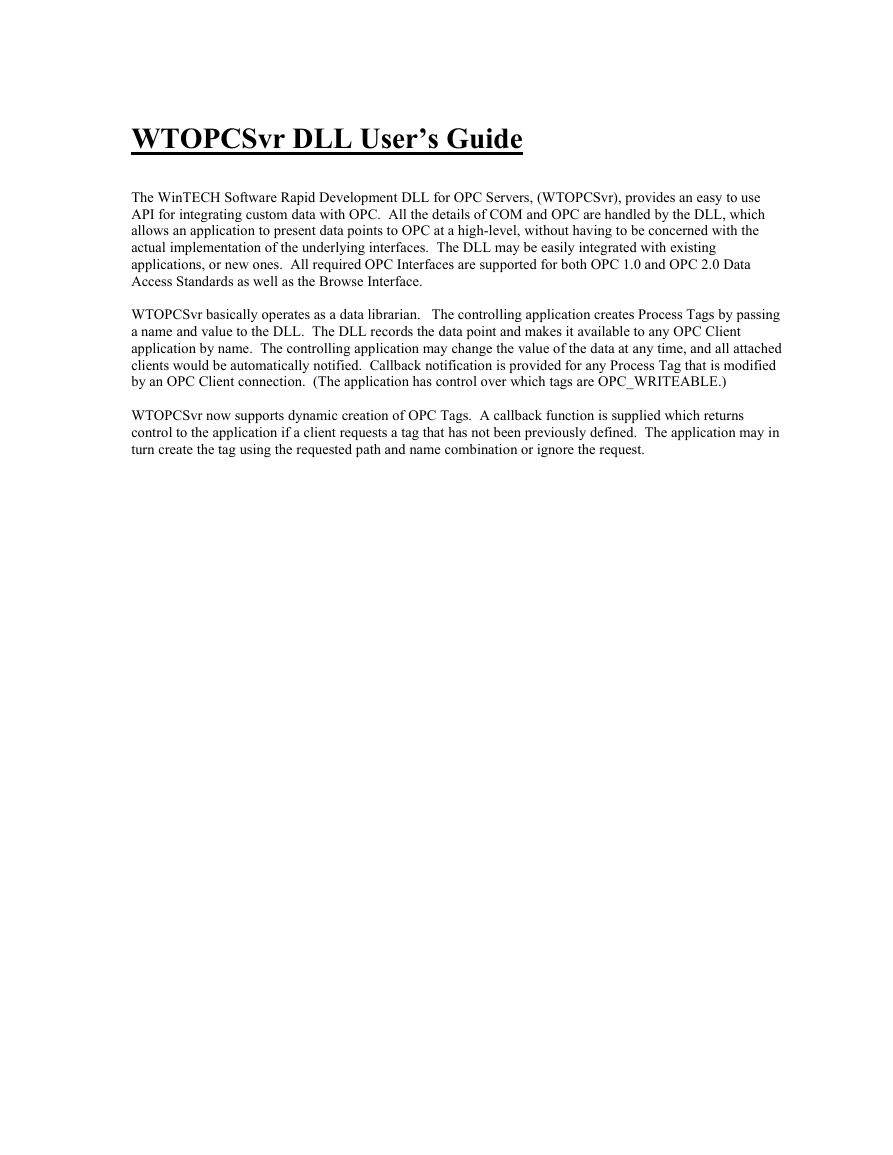
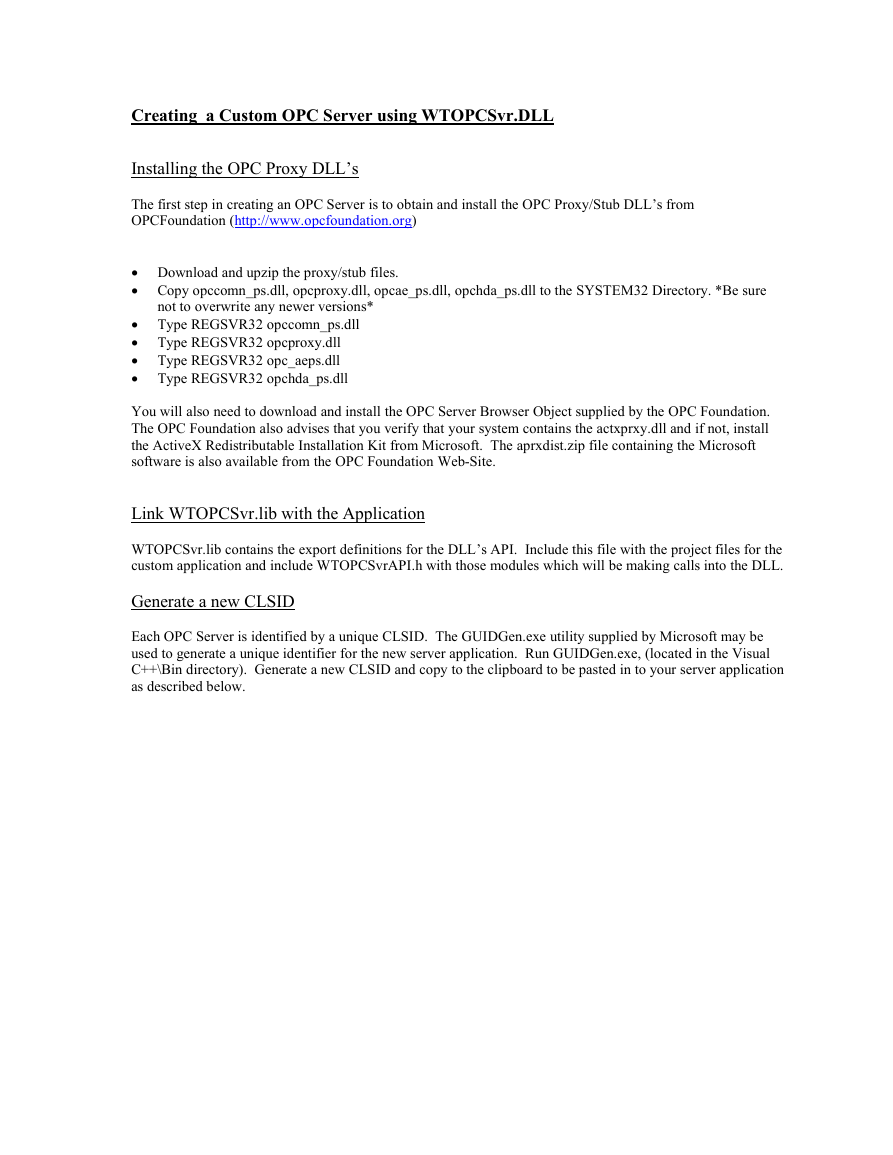
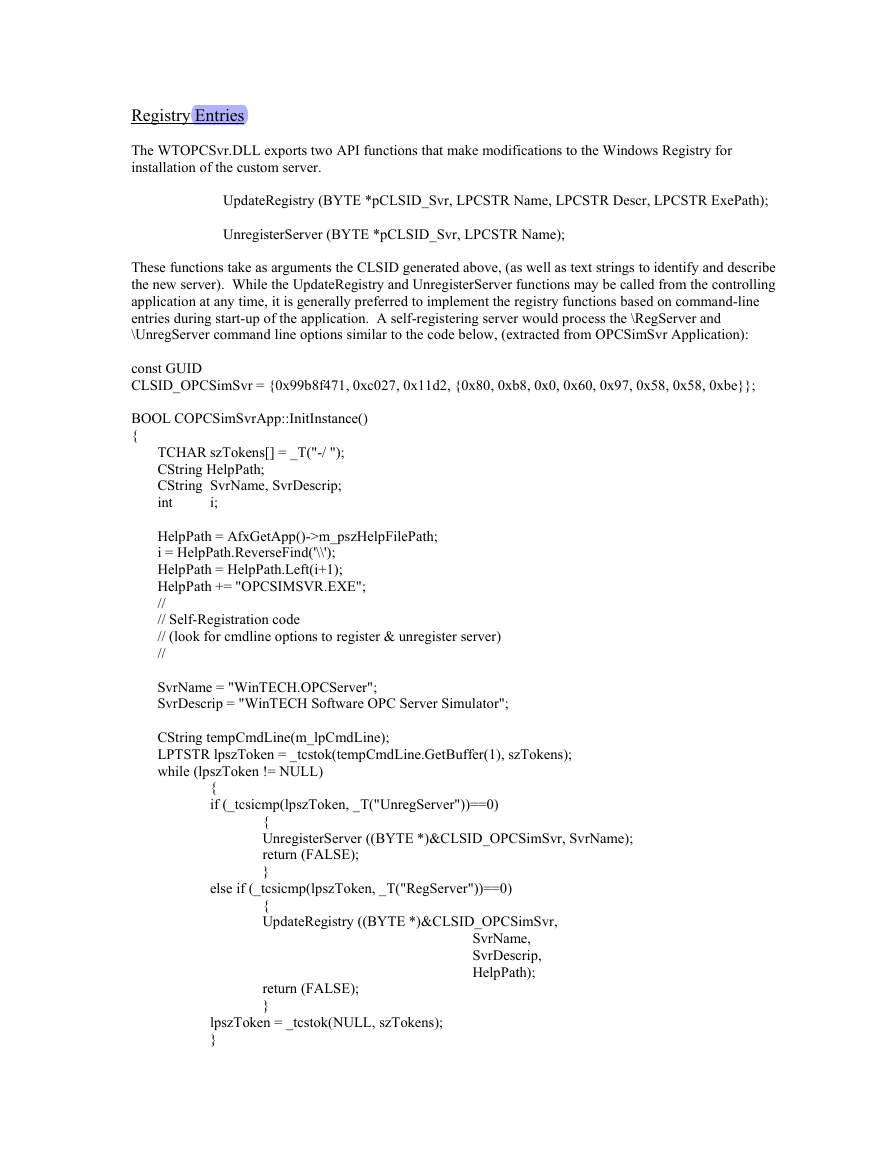
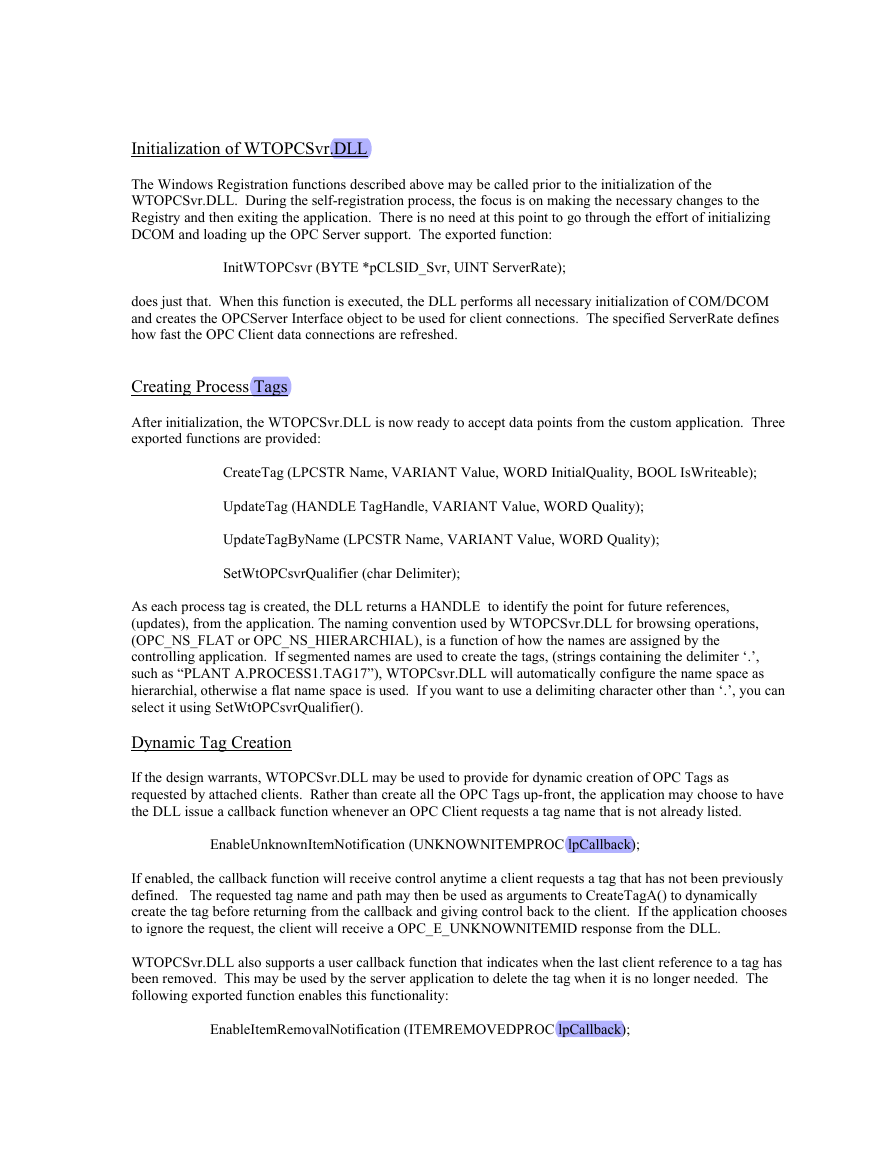
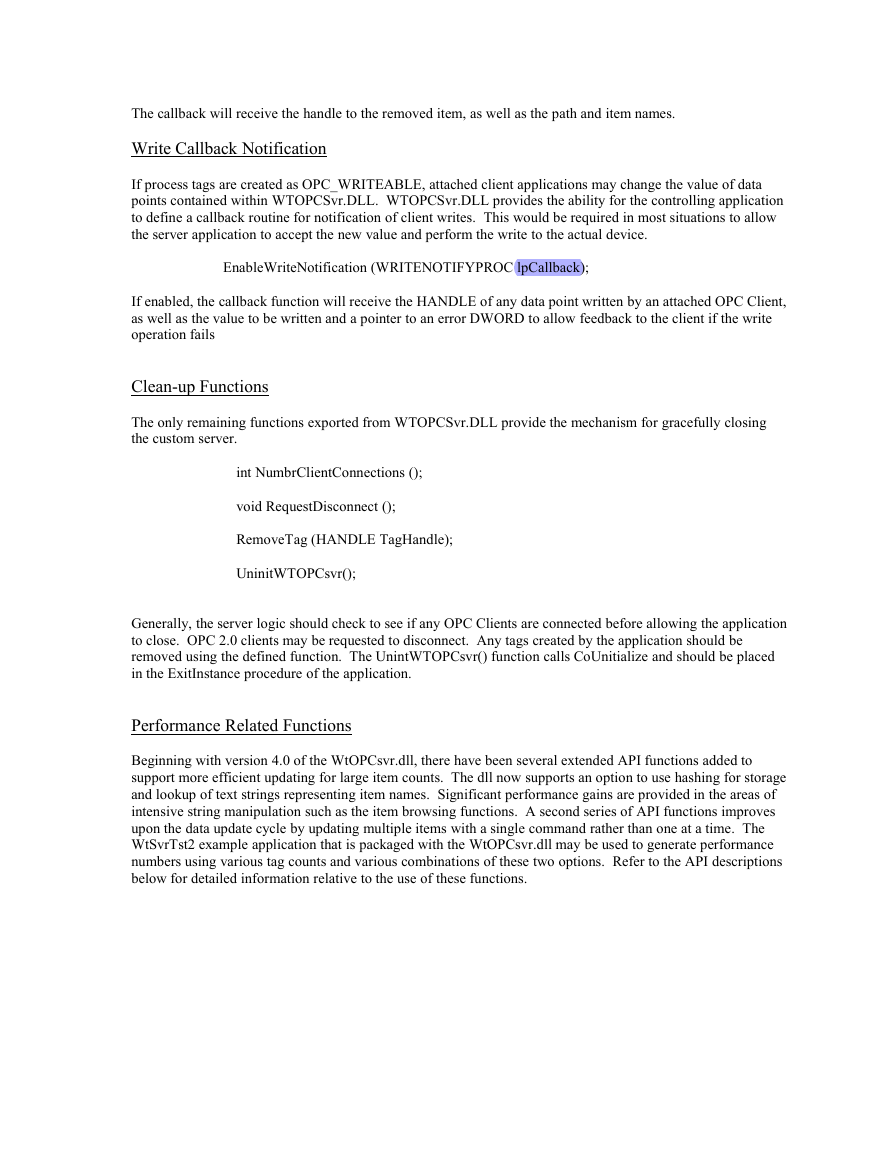
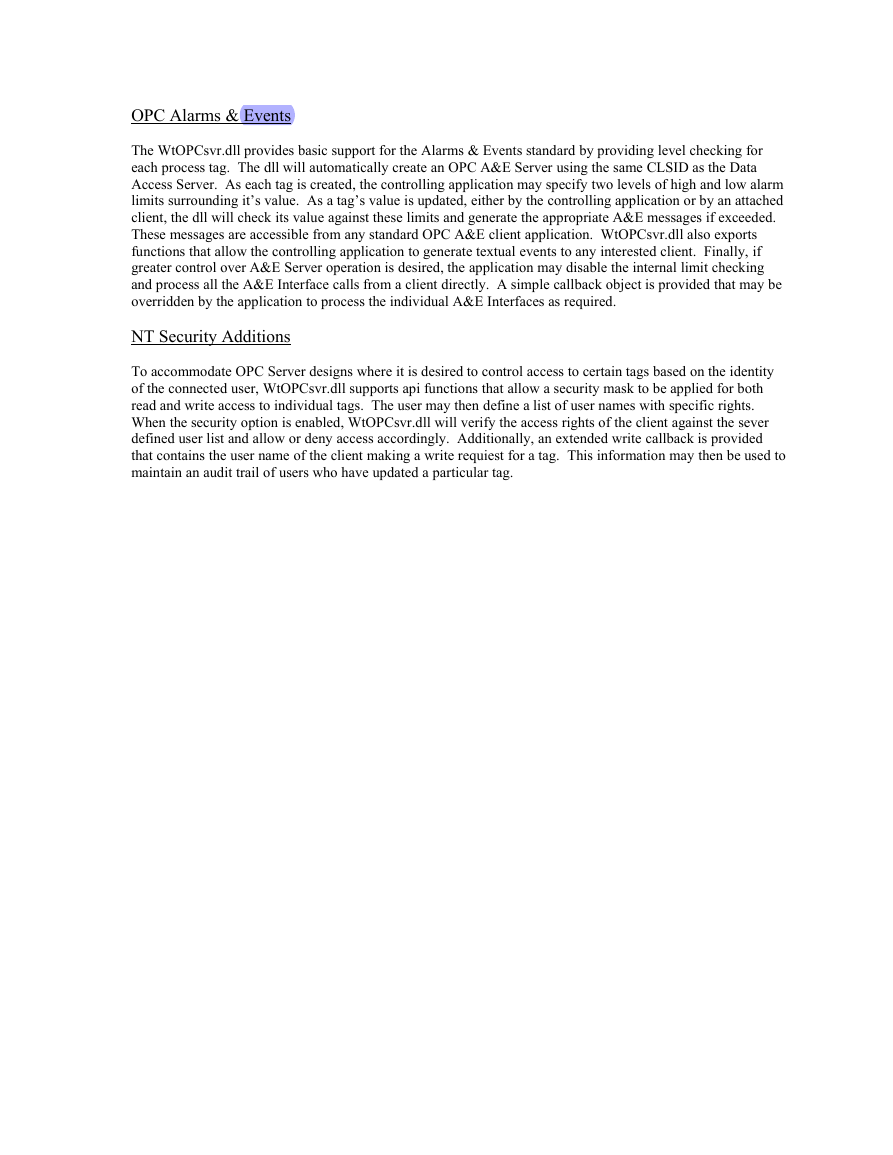
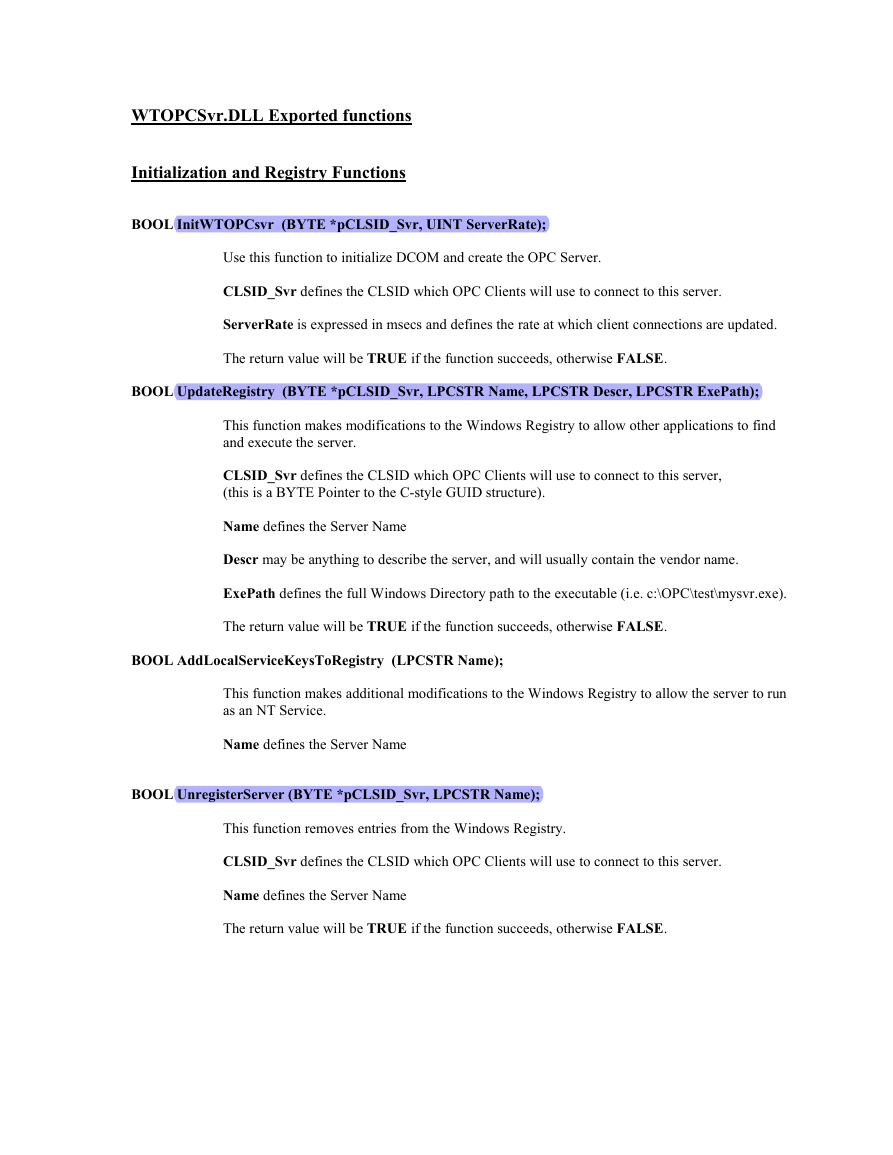









 2023年江西萍乡中考道德与法治真题及答案.doc
2023年江西萍乡中考道德与法治真题及答案.doc 2012年重庆南川中考生物真题及答案.doc
2012年重庆南川中考生物真题及答案.doc 2013年江西师范大学地理学综合及文艺理论基础考研真题.doc
2013年江西师范大学地理学综合及文艺理论基础考研真题.doc 2020年四川甘孜小升初语文真题及答案I卷.doc
2020年四川甘孜小升初语文真题及答案I卷.doc 2020年注册岩土工程师专业基础考试真题及答案.doc
2020年注册岩土工程师专业基础考试真题及答案.doc 2023-2024学年福建省厦门市九年级上学期数学月考试题及答案.doc
2023-2024学年福建省厦门市九年级上学期数学月考试题及答案.doc 2021-2022学年辽宁省沈阳市大东区九年级上学期语文期末试题及答案.doc
2021-2022学年辽宁省沈阳市大东区九年级上学期语文期末试题及答案.doc 2022-2023学年北京东城区初三第一学期物理期末试卷及答案.doc
2022-2023学年北京东城区初三第一学期物理期末试卷及答案.doc 2018上半年江西教师资格初中地理学科知识与教学能力真题及答案.doc
2018上半年江西教师资格初中地理学科知识与教学能力真题及答案.doc 2012年河北国家公务员申论考试真题及答案-省级.doc
2012年河北国家公务员申论考试真题及答案-省级.doc 2020-2021学年江苏省扬州市江都区邵樊片九年级上学期数学第一次质量检测试题及答案.doc
2020-2021学年江苏省扬州市江都区邵樊片九年级上学期数学第一次质量检测试题及答案.doc 2022下半年黑龙江教师资格证中学综合素质真题及答案.doc
2022下半年黑龙江教师资格证中学综合素质真题及答案.doc